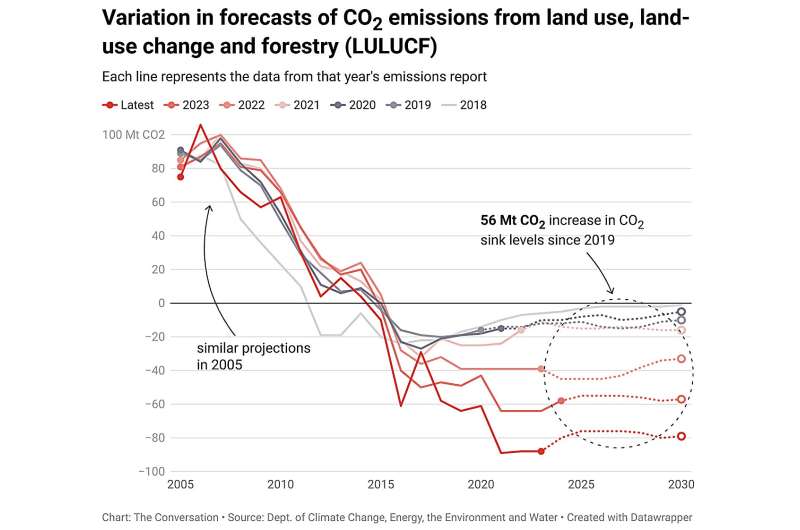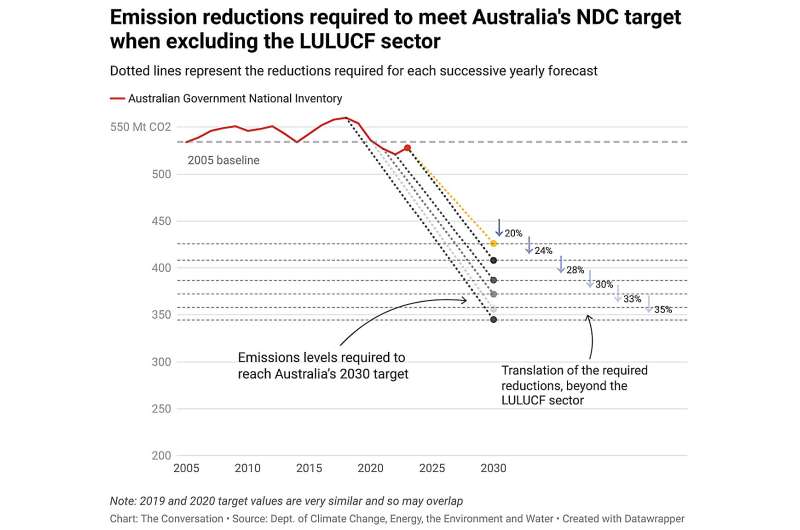This article has been reviewed according to Science X's editorial process and policies. Editors have highlighted the following attributes while ensuring the content's credibility:
fact-checked
trusted source
written by researcher(s)
proofread
Sleight of hand: Australia's Net Zero target is being lost in accounting tricks, offsets and more gas

In announcing Australia's support for fossil gas all the way to 2050 and beyond, Prime Minister Anthony Albanese has pushed his government's commitment to net zero even further out of reach.
When we published our analysis in December on Climate Action Tracker, a global assessment of government climate action, we warned Australia was unlikely to achieve its net zero target, and rated its efforts as "poor."
That's because Australia's long-term emissions reduction plan—released under the Morrison Coalition government and not yet revised by the Albanese Labor government—resorts to unrealistic technological fixes and emissions offsets.
But it's also because Labor's legislated target of a 43% emission cut by 2030 is not aligned with a 1.5°C pathway to net zero by 2050. Studies now show we need around a 70% reduction in net emissions—including the land use, land-use change and forestry sector—by 2030 to put Australia on track to net zero by 2050.
Why is this? Emissions from fossil fuel use, industry, agriculture and waste (for brevity, fossil fuel and industry) are the main driver of global warming. Most studies show these emissions (excluding land use) need about 50% reduction below 2005 levels by 2030 to be on path to net zero by 2050.
But when we take the government's projections for how much carbon the land use sector will soak up by 2030 into account, the cuts required for fossil fuel and industry emissions are even sharper: around a 70% fall in net emissions by 2030 to give us any chance of reaching net zero by 2050.
Policies designed to increase gas use and production for domestic use and export will make this harder still. Emissions from gas in Australia, including domestic use and the emissions from liquefying natural gas so it can be exported as LNG totaled about 24% of emissions in 2022. Processing gas into LNG accounted for about 9% of national emissions.
Gas cannot be green
Since our assessment, several huge gas projects have moved forward, including the carbon-intensive Barossa Pipeline and the development of the Beetaloo Basin fracking project to supply gas for domestic use in the Northern Territory and for export.
These projects will add between 3.5% and 15% to Australia's emissions, depending upon the scale of development. Our LNG export industry is by far the largest user of gas, accounting for 84% of all gas production.
Despite what Madeleine King, the federal minister for resources, might say, fossil gas is not a "transition fuel."
In the last decade it was the leading driver of the global increase in carbon dioxide emissions, contributing to close to half of their growth. In Australia coal and oil domestic emissions fell over the last decade but gas emissions increased by at least 16%.
At present, the only really effective climate action in the Australian economy is the decarbonization of the power sector. By 2023, renewable energy had reached around 37% of generation.
The states are responsible for the majority of this action, with the exception of Western Australia. While the latest federal budget spent on long-overdue climate measures such as green hydrogen, it's still far outweighed by spending on fossil fuels.
The government has allocated $22.7 billion over the next decade to the new "Future Made in Australia" policy, which is significant but outweighed by the $14.5 billion per year spent subsidizing fossil fuel use.
The policy's main incentive for hydrogen production is $6.7 billion over ten years, which does not start until 2027-28.
A paucity of policies
In March last year, the Labor government passed its flagship climate policy, the revised Safeguard Mechanism, which it claimed would address industry emissions, including gas production.
But by allowing almost unlimited offsets, this mechanism in fact enables more LNG export and development, with gas producers openly stating the mechanism will not change their plans.
And it hasn't.
A clear example is the NT government's recent contract with Tamboran Resources to take gas from the fracking of the Beetaloo basin.
Tamboran is also planning a massive new LNG export facility in Darwin at Middle Arm Point. Not only is this unimpeded by the safeguard mechanism, the federal government intends to support the Middle Arm hub with $1.5 billion. If this plant goes ahead at the scale Tamboran proposes, it would produce emissions equivalent to 11%–14% of Australia's total emissions in 2022 due to upstream development of the gas, as well as energy and gas used in LNG manufacture.
The government's future gas strategy appears to offer an open door for Woodside Energy to extend the life of its massive North West Shelf gas plant until 2070, decades after when the world should be at net zero.

The land sleight of hand
Because we have very few real emissions policies, our emissions in many sectors are actually rising. The best way to understand this trend is to remove the energy and land use sectors, so we can clearly see how much other areas are rising.
When you do, the data shows Australia's emissions jumped by 3% from 2022 to 2023 and are now 11% above 2005 levels, with the largest growth from transport.
Yet just as the Coalition did, our current government says emissions are dropping. How can this be?
Yes, energy emissions are dropping. But the real rub is in the famously malleable land use change and forestry sector.
This area is the only sector which can act as either a carbon sink or carbon source. If forests are regrowing fast, the sector acts as a sink, offsetting emissions from elsewhere.
If we include land and energy, emissions have now fallen 25% below 2005 levels as of 2023.
But if you exclude land use change, it's only a 1% decline in emissions.
Our own calculations show that successive governments have kept increasing their projections for how much carbon they believe the land use sector is storing. That's happened every year since 2018.
If you keep changing how big a carbon sink land use is, you seem to make the task of cutting emissions a lot easier. The topline figure of a 25% fall in emissions sounds great. But in reality, there's been very little change, if we avoid land use.
The Albanese government has now repeatedly changed how it calculates how much carbon the land sector is storing, as well as future projections. Between the end of 2021 and 2023, the government's figures changed markedly. Land use as a way to capture carbon soared, from 16 megatonnes of carbon dioxide equivalent a year to a whopping 88 megatonnes a year as of 2022.
This is a staggering 17% of Australia's 2022 fossil fuel and industry emissions. By changing these projections, our national emissions over 2022-23 magically appear to have fallen 6% in a year.
Every time the government recalculates how much carbon the land use sector is storing, the less work it has to do on actually cutting emissions from fossil fuels and industry sectors. That means it only needs emissions from fossil fuel use, industry, agriculture and waste to fall 24% by 2030, rather than 32%.
These changes to land use accounting may sound arcane, but they have very real consequences.
Offsets now in question
The Albanese government came to power promising action on climate and action on the environment. In the Government's Future Gas Strategy we are seeing clear avoidance of the scientific evidence on the need to rapidly reduce fossil gas use to limit warming 1.5C, and on how rubbery and questionable carbon offsets are. Its net zero target strategy includes 10% of offsets.
Scientists have recently published work showing that of 143 projects registered under the government's "Human Induced Regeneration" (HIR) offset program, the vast majority had seen minimal increases in carbon storage of less than 20%.
Most of these revegetation schemes had given us little or no real, additional and long-term increase in carbon storage, although the offsets have allowed real, additional carbon dioxide emissions to be pumped into the atmosphere, where they will remain for thousands of years.
No credible pathway
The only pathway we have left to limit warming to 1.5°C is political. Leaders must take up their responsibility to actually act and develop measures to rapidly cut carbon emissions.
Cutting emissions means not emitting them. Relying on offsets or changing how much we think the land is absorbing is not enough.
Sadly, our current government seems set on a sleight of hand. Rather than cutting fossil fuel and industry emissions 50% or more by 2030, as it should, the Australian government's changes to land use accounting mean it has to do much less.
This is not a credible pathway towards net zero.
Provided by The Conversation
This article is republished from The Conversation under a Creative Commons license. Read the original article.![]()




















